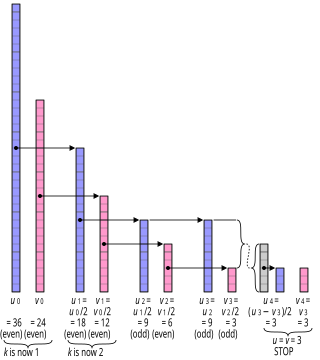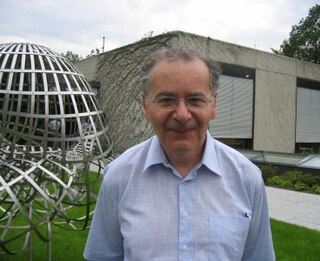Related Research Articles

In mathematics, the Euclidean algorithm, or Euclid's algorithm, is an efficient method for computing the greatest common divisor (GCD) of two integers (numbers), the largest number that divides them both without a remainder. It is named after the ancient Greek mathematician Euclid, who first described it in his Elements . It is an example of an algorithm, a step-by-step procedure for performing a calculation according to well-defined rules, and is one of the oldest algorithms in common use. It can be used to reduce fractions to their simplest form, and is a part of many other number-theoretic and cryptographic calculations.
In number theory, integer factorization is the decomposition, of a positive integer into a product of integers. If the factors are further restricted to be prime numbers, the process is called prime factorization, and includes the test whether the given integer is prime.

A prime number is a natural number greater than 1 that is not a product of two smaller natural numbers. A natural number greater than 1 that is not prime is called a composite number. For example, 5 is prime because the only ways of writing it as a product, 1 × 5 or 5 × 1, involve 5 itself. However, 4 is composite because it is a product (2 × 2) in which both numbers are smaller than 4. Primes are central in number theory because of the fundamental theorem of arithmetic: every natural number greater than 1 is either a prime itself or can be factorized as a product of primes that is unique up to their order.

Faltings's theorem is a result in arithmetic geometry, according to which a curve of genus greater than 1 over the field of rational numbers has only finitely many rational points. This was conjectured in 1922 by Louis Mordell, and known as the Mordell conjecture until its 1983 proof by Gerd Faltings. The conjecture was later generalized by replacing by any number field.
In commutative algebra and algebraic geometry, elimination theory is the classical name for algorithmic approaches to eliminating some variables between polynomials of several variables, in order to solve systems of polynomial equations.
In mathematics, the Gauss class number problem, as usually understood, is to provide for each n ≥ 1 a complete list of imaginary quadratic fields having class number n. It is named after Carl Friedrich Gauss. It can also be stated in terms of discriminants. There are related questions for real quadratic fields and for the behavior as .
In mathematics, Roth's theorem or Thue–Siegel–Roth theorem is a fundamental result in diophantine approximation to algebraic numbers. It is of a qualitative type, stating that algebraic numbers cannot have many rational number approximations that are 'very good'. Over half a century, the meaning of very good here was refined by a number of mathematicians, starting with Joseph Liouville in 1844 and continuing with work of Axel Thue (1909), Carl Ludwig Siegel (1921), Freeman Dyson (1947), and Klaus Roth (1955).

Serge Lang was a French-American mathematician and activist who taught at Yale University for most of his career. He is known for his work in number theory and for his mathematics textbooks, including the influential Algebra. He received the Frank Nelson Cole Prize in 1960 and was a member of the Bourbaki group.

The binary GCD algorithm, also known as Stein's algorithm or the binary Euclidean algorithm, is an algorithm that computes the greatest common divisor of two nonnegative integers. Stein's algorithm uses simpler arithmetic operations than the conventional Euclidean algorithm; it replaces division with arithmetic shifts, comparisons, and subtraction.
Hasse's theorem on elliptic curves, also referred to as the Hasse bound, provides an estimate of the number of points on an elliptic curve over a finite field, bounding the value both above and below.
Neal I. Koblitz is a Professor of Mathematics at the University of Washington. He is also an adjunct professor with the Centre for Applied Cryptographic Research at the University of Waterloo. He is the creator of hyperelliptic curve cryptography and the independent co-creator of elliptic curve cryptography.
Carl Bernard Pomerance is an American number theorist. He attended college at Brown University and later received his Ph.D. from Harvard University in 1972 with a dissertation proving that any odd perfect number has at least seven distinct prime factors. He joined the faculty at the University of Georgia, becoming full professor in 1982. He subsequently worked at Lucent Technologies for a number of years, and then became a distinguished Professor at Dartmouth College.
This is a glossary of arithmetic and diophantine geometry in mathematics, areas growing out of the traditional study of Diophantine equations to encompass large parts of number theory and algebraic geometry. Much of the theory is in the form of proposed conjectures, which can be related at various levels of generality.
A height function is a function that quantifies the complexity of mathematical objects. In Diophantine geometry, height functions quantify the size of solutions to Diophantine equations and are typically functions from a set of points on algebraic varieties to the real numbers.

Hendrik Willem Lenstra Jr. is a Dutch mathematician.

The following tables list the computational complexity of various algorithms for common mathematical operations.

Henri Cohen is a number theorist, and a professor at the University of Bordeaux. He is best known for leading the team that created the PARI/GP computer algebra system. He introduced the Rankin–Cohen bracket and has written several textbooks in computational and algebraic number theory.

Computational mathematics is an area of mathematics devoted to the interaction between mathematics and computer computation.
In mathematics, a fundamental discriminantD is an integer invariant in the theory of integral binary quadratic forms. If Q(x, y) = ax2 + bxy + cy2 is a quadratic form with integer coefficients, then D = b2 − 4ac is the discriminant of Q(x, y). Conversely, every integer D with D ≡ 0, 1 (mod 4) is the discriminant of some binary quadratic form with integer coefficients. Thus, all such integers are referred to as discriminants in this theory.
In mathematics, in the field of algebraic number theory, an S-unit generalises the idea of unit of the ring of integers of the field. Many of the results which hold for units are also valid for S-units.
References
- 1 2 Carl Pomerance (2009), Timothy Gowers (ed.), "Computational Number Theory" (PDF), The Princeton Companion to Mathematics, Princeton University Press
- ↑ Eric Bach; Jeffrey Shallit (1996). Algorithmic Number Theory, Volume 1: Efficient Algorithms. MIT Press. ISBN 0-262-02405-5.
- ↑ Henri Cohen (1993). A Course In Computational Algebraic Number Theory. Graduate Texts in Mathematics. Vol. 138. Springer-Verlag. doi:10.1007/978-3-662-02945-9. ISBN 0-387-55640-0.